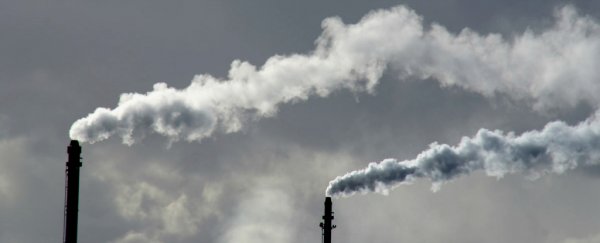For the first time, researchers have shown that they can capture CO2 from the air, and convert it directly into methanol, which can then be used as an alternative fuel, as well as for hydrogen storage, in fuel cells, or as a building block for plastic.
That's exciting, because it means that not only do we have one more reason to suck CO2 out of our atmosphere, but it can now very easily be recycled into something useful. "Direct CO2 capture and conversion to methanol using molecular hydrogen in the same pot was never achieved before," lead researcher G. K. Surya Prakash, from the University of Southern California, told Phys.org. "We have now done it!"
The creation of methane (CH3OH) from CO2 and hydrogen in itself is nothing new. But what's cool about this research is the team has identified a catalyst that speeds up the reaction and makes it a whole lot easier.
The catalyst is based on the metal ruthenium, and it's what's called a homogenous catalyst, which means it's in the same phase as the CO2 and hydrogen it reacts with.
Because of that, the CO2 doesn't need to be transformed after it's captured from the air, and can simply be added straight to hydrogen gas.
Initial tests have shown that the new catalyst, along with a few additional compounds, can convert up to an impressive 79 percent of CO2 captured from the air into methanol. At the end of the reaction, the methanol is mixed with water, but it can easily be distilled out, according to the scientists.
Importantly, the new catalyst is also reusable, so that reaction can happen over and over again.
The whole process sounds simple enough, but finding a catalyst with all those requirements that could also function at the high temperatures required for the reaction - around 150 degrees Celsius - had stumped scientists for years.
"Developing stable homogeneous catalysts for CO2 reduction to methanol was a challenge," said Prakash. "Majority of the catalysts stopped at the formic acid stage. Furthermore, we needed a catalyst that could reduce carbamates or alkylammonium bicarbonates directly to methanol. We have achieved both with our catalyst."
While it's great news for chemists everywhere, there's been some criticism of work such as this, which provides a practical use for atmospheric CO2, with some people saying it gives humanity permission to continue burning fossil fuels.
But the researchers simply hope their work will help to supplement the poor old carbon cycle, which we've broken by burning way more fossil fuels that can be recycled by our natural systems. If society starts using methanol as a source of fuel and energy, and can get that ethanol from excess CO2, then it might help restore the balance, they explain.
And with more than 70 million tonnes of methanol currently being produced each year by the chemical industry - usually to be later turned into plastic - the new technique could also help significantly reduce the financial and environmental costs of producing the substance.
Sure, a better solution would be to simply switch to all renewable sources, such as solar and wind, overnight, but until that happens, every little bit helps.
To that end, the researchers will now fine-tune their reaction to make it as efficient as possible. "We will continue the studies to develop more robust catalysts that work around 100 to 120 °C," Prakash told Lisa Zyga from Phys.org. "We would like to perform the chemistry in a preparatively useful way, wherein there are no solvent or reagent losses."
The research has been published in the Journal of American Chemical Society.
